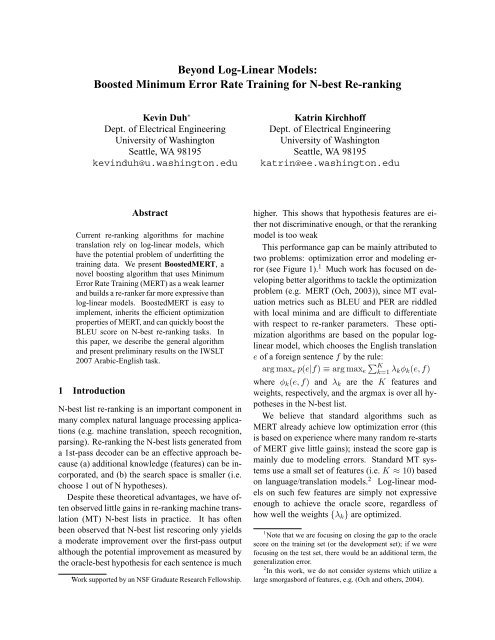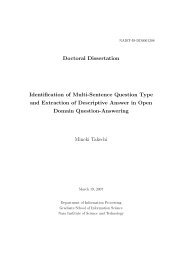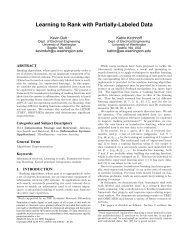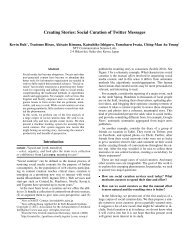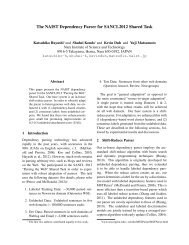Boosted Minimum Error Rate Training for N-best Re-ranking
Boosted Minimum Error Rate Training for N-best Re-ranking
Boosted Minimum Error Rate Training for N-best Re-ranking
Create successful ePaper yourself
Turn your PDF publications into a flip-book with our unique Google optimized e-Paper software.
Beyond Log-Linear Models:<br />
<strong>Boosted</strong> <strong>Minimum</strong> <strong>Error</strong> <strong>Rate</strong> <strong>Training</strong> <strong>for</strong> N-<strong>best</strong> <strong>Re</strong>-<strong>ranking</strong><br />
Kevin Duh ∗<br />
Dept. of Electrical Engineering<br />
University of Washington<br />
Seattle, WA 98195<br />
kevinduh@u.washington.edu<br />
Katrin Kirchhoff<br />
Dept. of Electrical Engineering<br />
University of Washington<br />
Seattle, WA 98195<br />
katrin@ee.washington.edu<br />
Abstract<br />
Current re-<strong>ranking</strong> algorithms <strong>for</strong> machine<br />
translation rely on log-linear models, which<br />
have the potential problem of underfitting the<br />
training data. We present <strong>Boosted</strong>MERT, a<br />
novel boosting algorithm that uses <strong>Minimum</strong><br />
<strong>Error</strong> <strong>Rate</strong> <strong>Training</strong> (MERT) as a weak learner<br />
and builds a re-ranker far more expressive than<br />
log-linear models. <strong>Boosted</strong>MERT is easy to<br />
implement, inherits the efficient optimization<br />
properties of MERT, and can quickly boost the<br />
BLEU score on N-<strong>best</strong> re-<strong>ranking</strong> tasks. In<br />
this paper, we describe the general algorithm<br />
and present preliminary results on the IWSLT<br />
2007 Arabic-English task.<br />
1 Introduction<br />
N-<strong>best</strong> list re-<strong>ranking</strong> is an important component in<br />
many complex natural language processing applications<br />
(e.g. machine translation, speech recognition,<br />
parsing). <strong>Re</strong>-<strong>ranking</strong> the N-<strong>best</strong> lists generated from<br />
a 1st-pass decoder can be an effective approach because<br />
(a) additional knowledge (features) can be incorporated,<br />
and (b) the search space is smaller (i.e.<br />
choose 1 out of N hypotheses).<br />
Despite these theoretical advantages, we have often<br />
observed little gains in re-<strong>ranking</strong> machine translation<br />
(MT) N-<strong>best</strong> lists in practice. It has often<br />
been observed that N-<strong>best</strong> list rescoring only yields<br />
a moderate improvement over the first-pass output<br />
although the potential improvement as measured by<br />
the oracle-<strong>best</strong> hypothesis <strong>for</strong> each sentence is much<br />
∗<br />
Work supported by an NSF Graduate <strong>Re</strong>search Fellowship.<br />
higher. This shows that hypothesis features are either<br />
not discriminative enough, or that the re<strong>ranking</strong><br />
model is too weak<br />
This per<strong>for</strong>mance gap can be mainly attributed to<br />
two problems: optimization error and modeling error<br />
(see Figure 1). 1 Much work has focused on developing<br />
better algorithms to tackle the optimization<br />
problem (e.g. MERT (Och, 2003)), since MT evaluation<br />
metrics such as BLEU and PER are riddled<br />
with local minima and are difficult to differentiate<br />
with respect to re-ranker parameters. These optimization<br />
algorithms are based on the popular loglinear<br />
model, which chooses the English translation<br />
e of a <strong>for</strong>eign sentence f by the rule:<br />
∑<br />
arg max e p(e|f) ≡ arg max K<br />
e k=1 λ kφ k (e, f)<br />
where φ k (e, f) and λ k are the K features and<br />
weights, respectively, and the argmax is over all hypotheses<br />
in the N-<strong>best</strong> list.<br />
We believe that standard algorithms such as<br />
MERT already achieve low optimization error (this<br />
is based on experience where many random re-starts<br />
of MERT give little gains); instead the score gap is<br />
mainly due to modeling errors. Standard MT systems<br />
use a small set of features (i.e. K ≈ 10) based<br />
on language/translation models. 2 Log-linear models<br />
on such few features are simply not expressive<br />
enough to achieve the oracle score, regardless of<br />
how well the weights {λ k } are optimized.<br />
1 Note that we are focusing on closing the gap to the oracle<br />
score on the training set (or the development set); if we were<br />
focusing on the test set, there would be an additional term, the<br />
generalization error.<br />
2 In this work, we do not consider systems which utilize a<br />
large smorgasbord of features, e.g. (Och and others, 2004).
BLEU=.56, achieved by<br />
selecting oracle hypotheses<br />
Modeling problem:<br />
Log-linear model insufficient?<br />
Optimization problem:<br />
Stuck in local optimum?<br />
BLEU=.40, achieved by<br />
re-<strong>ranking</strong> with MERT<br />
Figure 1: Both modeling and optimization problems increase<br />
the (training set) BLEU score gap between MERT<br />
re-<strong>ranking</strong> and oracle hypotheses. We believe that the<br />
modeling problem is more serious <strong>for</strong> log-linear models<br />
of around 10 features and focus on it in this work.<br />
To truly achieve the benefits of re-<strong>ranking</strong> in MT,<br />
one must go beyond the log-linear model. The reranker<br />
should not be a mere dot product operation,<br />
but a more dynamic and complex decision maker<br />
that exploits the structure of the N-<strong>best</strong> re-<strong>ranking</strong><br />
problem.<br />
We present <strong>Boosted</strong>MERT, a general framework<br />
<strong>for</strong> learning such complex re-rankers using standard<br />
MERT as a building block. <strong>Boosted</strong>MERT is easy to<br />
implement, inherits MERT’s efficient optimization<br />
procedure, and more effectively boosts the training<br />
score. We describe the algorithm in Section 2, report<br />
experiment results in Section 3, and end with related<br />
work and future directions (Sections 4, 5).<br />
2 <strong>Boosted</strong>MERT<br />
The idea <strong>for</strong> <strong>Boosted</strong>MERT follows the boosting<br />
philosophy of combining several weak classifiers<br />
to create a strong overall classifier (Schapire and<br />
Singer, 1999). In the classification case, boosting<br />
maintains a distribution over each training sample:<br />
the distribution is increased <strong>for</strong> samples that are incorrectly<br />
classified and decreased otherwise. In each<br />
boosting iteration, a weak learner is trained to optimize<br />
on the weighted sample distribution, attempting<br />
to correct the mistakes made in the previous iteration.<br />
The final classifier is a weighted combination<br />
of weak learners. This simple procedure is very effective<br />
in reducing training and generalization error.<br />
In <strong>Boosted</strong>MERT, we maintain a sample distribution<br />
d i , i = 1 . . . M over the M N-<strong>best</strong> lists. 3 In<br />
3 As such, it differs from RankBoost, a boosting-based <strong>ranking</strong><br />
algorithm in in<strong>for</strong>mation retrieval (Freund et al., 2003). If<br />
each boosting iteration t, MERT is called as as subprocedure<br />
to find the <strong>best</strong> feature weights λ t on d i . 4<br />
The sample weight <strong>for</strong> an N-<strong>best</strong> list is increased if<br />
the currently selected hypothesis is far from the oracle<br />
score, and decreased otherwise. Here, the oracle<br />
hypothesis <strong>for</strong> each N-<strong>best</strong> list is defined as the hypothesis<br />
with the <strong>best</strong> sentence-level BLEU. The final<br />
ranker is a combination of (weak) MERT ranker<br />
outputs.<br />
Algorithm 1 presents more detailed pseudocode.<br />
We use the following notation: Let {x i } represent<br />
the set of M training N-<strong>best</strong> lists, i = 1 . . . M. Each<br />
N-<strong>best</strong> list x i contains N feature vectors (<strong>for</strong> N hypotheses).<br />
Each feature vector is of dimension K,<br />
which is the same dimension as the number of feature<br />
weights λ obtained by MERT. Let {b i } be the<br />
set of BLEU statistics <strong>for</strong> each hypothesis in {x i },<br />
which is used to train MERT or to compute BLEU<br />
scores <strong>for</strong> each hypothesis or oracle.<br />
Algorithm 1 <strong>Boosted</strong>MERT<br />
Input: N-<strong>best</strong> lists {x i }, BLEU scores {b i }<br />
Input: Initialize sample distribution d i uni<strong>for</strong>mly<br />
Input: Initialize y 0 = [0], a constant zero vector<br />
Output: Overall Ranker: f T<br />
1: <strong>for</strong> t = 1 to T do<br />
2: Weak ranker: λ t = MERT({x i },{b i },d i )<br />
3:<br />
4: if (t ≥ 2): {y t−1 } = PRED(f t−1 , {x i })<br />
5: {y t } = PRED(λ t , {x i })<br />
6: α t = MERT([y t−1 ; y t ],{b i })<br />
7: Overall ranker: f t = y t−1 + α t y t<br />
8:<br />
9: <strong>for</strong> i = 1 to M do<br />
10: a i = [BLEU of hypothesis selected by f t ]<br />
divided by [BLEU of oracle hypothesis]<br />
11: d i = exp(−a i )/normalizer<br />
12: end <strong>for</strong><br />
13: end <strong>for</strong><br />
applied on MT, RankBoost would maintain a weight <strong>for</strong> each<br />
pair of hypotheses and would optimize a pairwise <strong>ranking</strong> metric,<br />
which is quite dissimilar to BLEU.<br />
4 This is done by scaling each BLEU statistic, e.g. n-gram<br />
precision, reference length, by the appropriate sample weights<br />
be<strong>for</strong>e computing corpus-level BLEU. Alternatively, one could<br />
sample (with replacement) the N-<strong>best</strong> lists using the distribution<br />
and use the resulting stochastic sample as input to an unmodified<br />
MERT procedure.
The pseudocode can be divided into 3 sections:<br />
1. Line 2 finds the <strong>best</strong> log-linear feature weights<br />
on distribution d i . MERT is invoked as a weak<br />
learner, so this step is computationally efficient<br />
<strong>for</strong> optimizing MT-specific metrics.<br />
2. Lines 4-7 create an overall ranker by combining<br />
the outputs of the previous overall ranker<br />
f t−1 and current weak ranker λ t . PRED is a<br />
general function that takes a ranker and a M<br />
N-<strong>best</strong> lists and generates a set of M N-dim<br />
output vector y representing the predicted reciprocal<br />
rank. Specifically, suppose a 3-<strong>best</strong> list<br />
and a ranker predicts ranks (1,3,2) <strong>for</strong> the 1st,<br />
2nd, and 3rd hypotheses, respectively. Then<br />
y = (1/1,1/3,1/2) = (1,0.3,0.5). 5<br />
Finally, using a 1-dimensional MERT, the<br />
scalar parameter α t is optimized by maximizing<br />
the BLEU of the hypothesis chosen by<br />
y t−1 +α t y t . This is analogous to the line search<br />
step in boosting <strong>for</strong> classification (Mason et al.,<br />
2000).<br />
3. Lines 9-11 update the sample distribution d i<br />
such that N-<strong>best</strong> lists with low accuracies a i<br />
are given higher emphasis in the next iteration.<br />
The per-list accuracy a i is defined as the ratio of<br />
selected vs. oracle BLEU, but other measures<br />
are possible: e.g. ratio of ranks, difference of<br />
BLEU.<br />
The final classifier f T can be seen as a voting procedure<br />
among multiple log-linear models generated<br />
by MERT. The weighted vote <strong>for</strong> hypotheses in an<br />
N-<strong>best</strong> list x i is represented by the N-dimensional<br />
vector: ŷ = ∑ T<br />
t=1 αt y t = ∑ T<br />
t=1 αt PRED(λ t , x i ).<br />
We choose the hypothesis with the maximum value<br />
in ŷ<br />
Finally, we stress that the above algorithm<br />
is an novel extension of boosting to re-<strong>ranking</strong><br />
problems. There are many open questions and<br />
one can not always find a direct analog between<br />
boosting <strong>for</strong> classification and boosting <strong>for</strong> <strong>ranking</strong>.<br />
For instance, the distribution update scheme<br />
5 There are other ways to define a <strong>ranking</strong> output that are<br />
worth exploring. For example, a hard argmax definition would<br />
be (1,0,0); a probabilistic definition derived from the dot product<br />
values can also be used. It is the definition of PRED that<br />
introduces non-linearities in <strong>Boosted</strong>MERT.<br />
of Lines 9-11 is recursive in the classification<br />
case (i.e. d i = d i ∗ exp(LossOfWeakLearner)),<br />
but due to the non-decompositional properties of<br />
arg max in re-<strong>ranking</strong>, we have a non-recursive<br />
equation based on the overall learner (d i =<br />
exp(LossOfOverallLearner)). This has deep implications<br />
on the dynamics of boosting, e.g. the distribution<br />
may stay constant in the non-recursive equation,<br />
if the new weak ranker gets a small α.<br />
3 Experiments<br />
The experiments are done on the IWSLT 2007<br />
Arabic-to-English task (clean text condition). We<br />
used a standard phrase-based statistical MT system<br />
(Kirchhoff and Yang, 2007) to generated N-<strong>best</strong> lists<br />
(N=2000) on Development4, Development5,<br />
and Evaluation sub-sets. Development4 is<br />
used as the Train set; N-<strong>best</strong> lists that have the same<br />
sentence-level BLEU statistics <strong>for</strong> all hypotheses are<br />
filtered since they are not important in impacting<br />
training. Development5 is used as Dev set (in<br />
particular, <strong>for</strong> selecting the number of iterations in<br />
boosting), and Evaluation (Eval) is the blind<br />
dataset <strong>for</strong> final ranker comparison. Nine features<br />
are used in re-<strong>ranking</strong>.<br />
We compare MERT vs. <strong>Boosted</strong>MERT. MERT is<br />
randomly re-started 30 times, and <strong>Boosted</strong>MERT is<br />
run <strong>for</strong> 30 iterations, which makes <strong>for</strong> a relatively<br />
fair comparison. MERT usually does not improve<br />
its Train BLEU score, even with many random restarts<br />
(again, this suggests that optimization error<br />
is low). Table 1 shows the results, with <strong>Boosted</strong>-<br />
MERT outper<strong>for</strong>ming MERT 42.0 vs. 41.2 BLEU<br />
on Eval. <strong>Boosted</strong>MERT has the potential to achieve<br />
43.7 BLEU, if a better method <strong>for</strong> selecting optimal<br />
iterations can be devised.<br />
It should be noted that the Train scores achieved<br />
by both MERT and <strong>Boosted</strong>MERT is still far from<br />
the oracle (around 56). We found empirically that<br />
<strong>Boosted</strong>MERT is somewhat sensitive to the size (M)<br />
of the Train set. For small Train sets, <strong>Boosted</strong>MERT<br />
can improve the training score quite drastically; <strong>for</strong><br />
the current Train set as well as other larger ones, the<br />
improvement per iteration is much slower. We plan<br />
to investigate this in future work.
MERT BOOST ∆<br />
Train, Best BLEU 40.3 41.0 0.7<br />
Dev, Best BLEU 24.0 25.0 1.0<br />
Eval, Best BLEU 41.2 43.7 2.5<br />
Eval, Selected BLEU 41.2 42.0 0.8<br />
Table 1: The first three rows show the BLEU score <strong>for</strong><br />
Train, Dev, and Eval from 30 iterations of <strong>Boosted</strong>MERT<br />
or 30 random re-restarts of MERT. The last row shows<br />
the actual BLEU on Eval when selecting the number<br />
of boosting iterations based on Dev. Last column indicates<br />
absolute improvements. <strong>Boosted</strong>MERT outper<strong>for</strong>ms<br />
MERT by 0.8 points on Eval.<br />
4 <strong>Re</strong>lated Work<br />
Various methods are used to optimize log-linear<br />
models in re-<strong>ranking</strong> (Shen et al., 2004; Venugopal<br />
et al., 2005; Smith and Eisner, 2006). Although<br />
this line of work is worthwhile, we believe more<br />
gain is possible if we go beyond log-linear models.<br />
For example, Shen’s method (2004) produces largemargins<br />
but observed little gains in per<strong>for</strong>mance.<br />
Our <strong>Boosted</strong>MERT should not be confused with<br />
other boosting algorithms such as (Collins and Koo,<br />
2005; Kudo et al., 2005). These algorithms are<br />
called boosting because they iteratively choose features<br />
(weak learners) and optimize the weights <strong>for</strong><br />
the boost/exponential loss. They do not, however,<br />
maintain a distribution over N-<strong>best</strong> lists.<br />
The idea of maintaining a distribution over N-<br />
<strong>best</strong> lists is novel. To the <strong>best</strong> of our knowledge,<br />
the most similar algorithm is AdaRank (Xu and Li,<br />
2007), developed <strong>for</strong> document <strong>ranking</strong> in in<strong>for</strong>mation<br />
retrieval. Our main difference lies in Lines 4-7<br />
in Algorithm 1: AdaRank proposes a simple closed<br />
<strong>for</strong>m solution <strong>for</strong> α and combines only weak features,<br />
not full learners (as in MERT). We have also<br />
implemented AdaRank but it gave inferior results.<br />
It should be noted that the theoretical training<br />
bounds derived in the AdaRank paper is relevant<br />
to <strong>Boosted</strong>MERT. Similar to standard boosting, this<br />
bound shows that the training score can be improved<br />
exponentially in the number of iterations. However,<br />
we found that the conditions <strong>for</strong> which this bound is<br />
applicable is rarely satisfied in our experiments. 6<br />
6 The explanation <strong>for</strong> this is beyond the scope of this paper;<br />
the basic reason is that our weak rankers (MERT) are not weak<br />
in practice, so that successive iterations get diminishing returns.<br />
5 Conclusions<br />
We argue that log-linear models often underfit the<br />
training data in MT re-<strong>ranking</strong>, and that this is the<br />
reason we observe a large gap between re-ranker and<br />
oracle scores. Our solution, <strong>Boosted</strong>MERT, creates<br />
a highly-expressive ranker by voting among multiple<br />
MERT rankers.<br />
Although <strong>Boosted</strong>MERT improves over MERT,<br />
more work at both the theoretical and algorithmic<br />
levels is needed to demonstrate even larger gains.<br />
For example, while standard boosting <strong>for</strong> classification<br />
can exponentially reduce training error in the<br />
number of iterations under mild assumptions, these<br />
assumptions are frequently not satisfied in the algorithm<br />
we described. We intend to further explore<br />
the idea of boosting on N-<strong>best</strong> lists, drawing inspirations<br />
from the large body of work on boosting <strong>for</strong><br />
classification whenever possible.<br />
<strong>Re</strong>ferences<br />
M. Collins and T. Koo. 2005. Discriminative re<strong>ranking</strong><br />
<strong>for</strong> natural langauge parsing. Computational Linguistics,<br />
31(1).<br />
Y. Freund, R. Iyer, R.E. Schapire, and Y. Singer. 2003.<br />
An efficient boosting algorithm <strong>for</strong> combining preferences.<br />
Journal of Machine Learning <strong>Re</strong>search, 4.<br />
K. Kirchhoff and M. Yang. 2007. The UW machine<br />
translation system <strong>for</strong> IWSLT 2007. In IWSLT.<br />
T. Kudo, J. Suzuki, and H. Isozaki. 2005. Boostingbased<br />
parse re<strong>ranking</strong> with subtree features. In ACL.<br />
L. Mason, J. Baxter, P. Bartless, and M. Frean. 2000.<br />
Boosting as gradient descent. In NIPS.<br />
F.J. Och et al. 2004. A smorgasbord of features <strong>for</strong> statistical<br />
machine translation. In HLT/NAACL.<br />
F.J. Och. 2003. <strong>Minimum</strong> error rate training in statistical<br />
machine translation. In ACL.<br />
R. E. Schapire and Y. Singer. 1999. Improved boosting<br />
algorithms using confidence-rated predictions. Machine<br />
Learning, 37(3).<br />
L. Shen, A. Sarkar, and F.J. Och. 2004. Discriminative<br />
re<strong>ranking</strong> <strong>for</strong> machine translation. In HLT-NAACL.<br />
D. Smith and J. Eisner. 2006. <strong>Minimum</strong> risk annealing<br />
<strong>for</strong> training log-linear models. In Proc. of COL-<br />
ING/ACL Companion Volume.<br />
A. Venugopal, A. Zollmann, and A. Waibel. 2005. <strong>Training</strong><br />
and evaluating error minimization rules <strong>for</strong> SMT.<br />
In ACL Workshop on Building/Using Parallel Texts.<br />
J. Xu and H. Li. 2007. AdaRank: A boosting algorithm<br />
<strong>for</strong> in<strong>for</strong>mation retrieval. In SIGIR.


